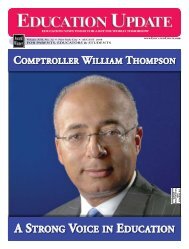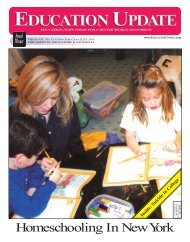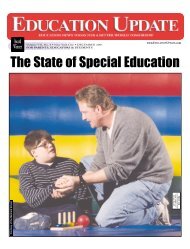Download PDF - Education Update
Download PDF - Education Update
Download PDF - Education Update
You also want an ePaper? Increase the reach of your titles
YUMPU automatically turns print PDFs into web optimized ePapers that Google loves.
18 spotlight on schools ■ EDUCATION UPDATE ■ NOV/DEC 2010Wallace Foundation Finds Out-of-School Programs Are a SuccessStudents Shine AtVoyages Prep H.S.By Adam BlochOver the past several years, the WallaceFoundation has undertaken major projects infive American cities to improve and monitorout-of-school time (OST) activities. In October,the first results and reactions were revealed ina three-volume, 255-page study by the RANDCorporation, titled “Hours of Opportunity.”The goal of the project was to figure out howall municipal and community resources couldbest be organized and administered to providechildren with high-quality after-school, weekendand summer programs. The RAND reportprovides an affirming evaluation, concludingthat Wallace’s efforts were successful and thatcities can effectively marshal their myriad OSTactivities to provide better and more enrichingservices.“The RAND study found improvements inaccess to programs and in program qualitybecause of the citywide changes implemented,”said Edward Pauly, director of research andevaluation at the Wallace Foundation, a privatecharitable foundation that promotes educationaland cultural programs. “We take particularpleasure in the RAND finding that all five citiesmade important progress. They did it in differentways and in very different contexts, but allfive cities were able to build a citywide level ofsupport for out of school programs, and othercities can do the same.”The five cities in question were Providence,New York (which both joined the study in2003), Chicago, Boston and Washington, D.C.(which joined in 2005). Each city offered differentchallenges and frameworks. The populationrange, Pauly pointed out, from roughlya couple of hundred thousand in Providenceto eight million in New York, offers usableexamples for other cities across the countryto follow. Each city was awarded grant moneyranging from $5 million to $12 million.Among the major findings was that thereis no single best method of improving OSTprograms. Rather, different approaches workbetter in each city because of local conditions.Providence, for example, focused on expandingand improving existing activities whileadding transportation and coordination. NewYork, on the other hand, emphasized improvingprograms in high-need areas, increasingdata collection and adding better staff training.Outcomes were measured in different ways ineach city: for example, Chicago used schoolrecords, while New York relied on participantevaluations. The RAND study also foundthat “management information systems” wereessential in organizing programs more effectively,monitoring outcomes and directing fundsin an efficient manner.By Richard KaganTeacher Evaluationcontinued from page 14Edward Pauly, Wallace Foundation“In New York, attendance and participationdata were used to trigger check-ins by cityagencies for quality control purposes,” Paulysaid. “Having the first clear reliable data sourceson the number of kids enrolled, their attendance,which programs they attended, and howlong they were in those programs was essentialin allocating funding. Data doesn’t cause moremoney to be allocated, but if you don’t have thedata the people who do the allocating are goingto be more skeptical.”Support from school and city leaders, especiallyfrom mayors, was also an essentialcharacteristic of successful programs. “Supportfrom mayors was sustained throughout thestudy,” Pauly said. “One of the findings wasthe central role that mayors play on this issue.”Challenges remain for the five cities inWallace’s project and others around the countrythat would implement similar programs.Pauly acknowledged that logistical difficultieslike transportation, safety and liability are stillbarriers. And the seed money provided by thefoundation is not something easily replicatedon a wide scale, especially in a time of budgetcutbacks.But RAND’s report affirms the study’s successand offers other cities a path to achievesimilar results. #incite a sense of curiosity about a subject, instilla sense of purpose and direction to one’s life,and spark creativity and commitment. There’slittle reason to think that these important typesof learning would be picked up by a standardizedtest of mastery of physics, or of any other schoolsubject. Without doubt, it might be difficult todetermine how to assess how teachers contributeto these kinds of longer-term outcomes; butthat’s not a reason to ignore them.Second, the notion that a teacher contributesto her students’ learning of school subjectsimplies that we have some sense of what thosestudents knew before they came into contactwith that teacher. In recent years, a statisticaltechnique called value-added measurementhas sought to isolate the impact of a particularteacher on student achievement, using the standardizedtests which students in the elementaryand middle school grades take annually. Butsuch measures, which are the basis for the controversialTeacher Data Reports in New YorkCity, are an imprecise method for identifyinggood teachers, and in any event are only applicableto teachers who teach subjects which aretested each year. Moreover, they tell us nothingabout the nature of good teaching. Experts agreethat value-added measures of teacher effectivenessshould not be used as the primary basis forevaluating teachers, especially for high-stakesdecisions like tenure.The second approach to identifying good teachersis focusing on their practices. Teaching is anextraordinarily complex activity, and becauseclassrooms and students differ in so many unpredictableways, no two instances of teaching areever identical. There is, nevertheless, a growingconsensus about the teaching practices associatedwith planning, instruction and assessmentwhich maximize the likelihood that students willlearn. Observing and rating classroom practiceis thus another strategy for identifying goodteachers. With proper training, school principalsand teachers can observe classroom teaching andTo fully appreciate Voyages Preparatory HighSchool in Elmhurst, Queens you need to talk tothe students.One student said, “It’s a fun school. It makesyou want to come here. If you don’t want to getup, they call you.” Another student, Diane Lopez,of Ozone Park, Queens, noted, “We know everybody.We’re small, we are on one floor.” Lopezis also enthusiastic about going to school. “Theymake it fun”, she said. “It’s not, oh my God, Ihate school. We just wake up and come here.”These are statements from students who hadtrouble getting to school and who put their educationin jeopardy. But they found the 3-year-oldVoyages High School, transferred in, and becameengaged in the learning process.Andy Mikhail graduated last June and nowplays basketball at Hudson Valley CommunityCollege in Albany, New York. Mikhail playedvarsity basketball on the new basketball team atVoyages, got bitten by the basketball bug, anddreams of playing in a Division 1 program, thehighest competitive level of college basketball.He said of Voyages, “It’s a very good school. Itbenefits a lot of people.”Voyages stands for Viable Options for YoungAdults to Grow, Excel and Succeed and is led bythe passionate and dedicated principal, Dr. JoanKlingsberg. Dr. Klingsberg has more than 25years of experience as a teacher, teacher trainer,and specialist in professional development in theNew York City Department of <strong>Education</strong>. Shereceived her Doctor of <strong>Education</strong> degree fromColumbia University’s Teachers College. Shewanted to lead a school that served students whowere overage and under-credited. She developed aproposal and pitched it to the Board of <strong>Education</strong>and her idea was approved. Space was found in arefurbished building which houses other schools.Voyages occupies the entire second floor of alarge building on 94th Street in Elmhurst.For many students, it is a place that helpsthem get back on track after years of failure andfrustration. Voyages reaches those who were theoutcasts, the ones who flunked courses, or whosimply didn’t show up for class. They accept thestudent who had given up on school and didn’timagine having a future, much less going to college.“They have been on their own a really, reallylong time and perfected bad habits,” Dr.Klingsberg said. “We’re about undoing thosehabits.”This is being done with a concerted effort byteachers, parents, merchants in the communityand non-profit groups who assist with personnelor funds.Teachers come to the school and because ofthe peer support and the general positive attitudefrom Dr. Klingsberg, they grow and becomebetter teachers. In three years, only one teacherhad left the school after deciding not to continueteaching. The faculty consists of the same coregroup, including the principal. New teachersare asked to give a demonstration class, whichis critiqued by students. A new teacher mustalso present a letter of recommendation from anadolescent.What helps attract teachers to Voyages is theintense professional development that they frequentlyreceive. When the school breaks forlunch, 225 kids leave the building, and the teachersare involved in learning how they can improveas an educator. “Quite honestly, it’s the highlightof everybody’s day,” said Dr. Klingsberg.Teachers look forward to helping each otheragree on what they see and what it means.Both approaches to identifying good teachersare in their infancy, although there is good reasonto think that we can get better at both of them.Neither approach is likely to be satisfactory inisolation from the other. If we are willing toinvest in the development of better measures ofDr. Joan Klingsbergbecome better communicators, to assessing eachother’s lesson plans, and looking for strategies toreach out to their students.Voyages makes an effort to communicate withparents and keep them in the loop.A parent-teacher conference is planned for theentire school in late October. Parents can come toschool and learn what their child is doing in classand meet their teachers.A day is also being planned to have parentssit in with their child in class. The students areaware of this, and some feel anxious, but overall,the feeling is that they want their parents to seehow well they are doing academically and thatthey like being in school.Dr. Klingsberg and the staff have created anatmosphere of openness, trust and self-responsibility.Once a student has been accepted intothe program, they may feel wary and defensive.“You have to prove to them that you genuinelycare,” said Dr. Klingsberg.“Once they know that someone genuinelycares, they will do whatever you ask to levels thatyou never thought possible.”Students took this reporter on a tour of classroomsand proudly showed the art room, whichlooked like an artist’s studio, and their weightroom, which had brand new equipment.Voyages also has a Learning to Work program,which funds 90 students to intern at an hourlyrate. The Queens Community House, a local nonprofitgroup, has been instrumental in providingprofessional support and funds to make this aviable program.Dr. Klingsberg made it clear that students mustpass five Regents Exams to earn their diploma.Students do their assigned homework and meettheir goals, and get rewarded with a “star student”award. She notes the school is big on celebrationsand acknowledging achieved goals.Denea Fleary, a student who plans to graduateafter the November trimester, hopes to work withanimals. Earning a high school diploma will bringher dream closer to reality. “You get a diplomaand get to go on with your life,” she said. #student learning and of good teaching practice,we can do much better than simply asserting,with a minimum of evidence, that a particularteacher is either good or bad at his job. #Aaron Pallas, Ph.D. is Professor of Sociologyand <strong>Education</strong> at Teachers College, ColumbiaUniversity.
















